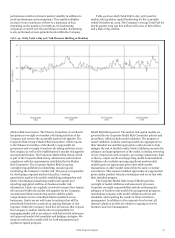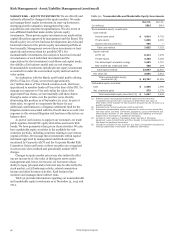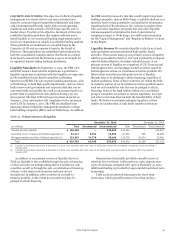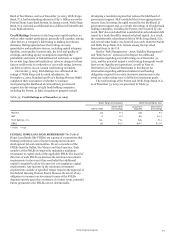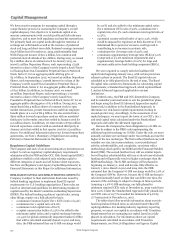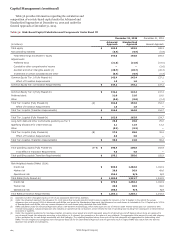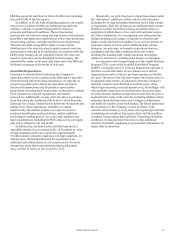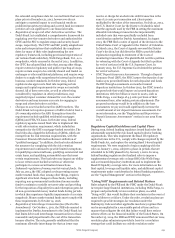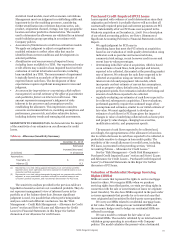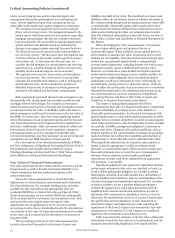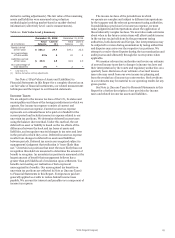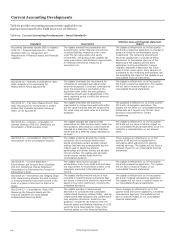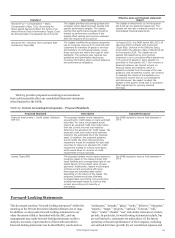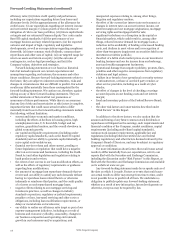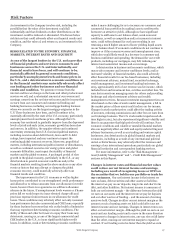Wells Fargo 2015 Annual Report Download - page 109
Download and view the complete annual report
Please find page 109 of the 2015 Wells Fargo annual report below. You can navigate through the pages in the report by either clicking on the pages listed below, or by using the keyword search tool below to find specific information within the annual report.FRB has moved the start date for future CCAR cycles, including
the 2016 CCAR, to the first quarter.
In addition to CCAR, federal banking regulators also require
stress tests to evaluate whether an institution has sufficient
capital to continue to operate during periods of adverse
economic and financial conditions. These stress testing
requirements set forth the timing and type of stress test activities
large BHCs and banks must undertake as well as rules governing
stress testing controls, oversight and disclosure requirements.
The rules also limit a large BHC’s ability to make capital
distributions to the extent its actual capital issuances were less
than amounts indicated in its capital plan. As required under the
FRB’s stress testing rule, we completed a mid-cycle stress test
based on data and scenarios developed by the Company. We
submitted the results of the mid-cycle stress test to the FRB and
disclosed a summary of the results in July 2015.
Securities Repurchases
From time to time the Board authorizes the Company to
repurchase shares of our common stock. Although we announce
when the Board authorizes share repurchases, we typically do
not give any public notice before we repurchase our shares.
Future stock repurchases may be private or open-market
repurchases, including block transactions, accelerated or delayed
block transactions, forward transactions, and similar
transactions. Additionally, we may enter into plans to purchase
stock that satisfy the conditions of Rule 10b5-1 of the Securities
Exchange Act of 1934. Various factors determine the amount and
timing of our share repurchases, including our capital
requirements, the number of shares we expect to issue for
employee benefit plans and acquisitions, market conditions
(including the trading price of our stock), and regulatory and
legal considerations, including the FRB’s response to our capital
plan and to changes in our risk profile.
In March 2014, the Board authorized the repurchase of
350 million shares of our common stock. At December 31, 2015,
we had remaining authority to repurchase approximately
77 million shares, subject to regulatory and legal conditions. In
January 2016, the Board authorized the repurchase of an
additional 350 million shares of our common stock. For more
information about share repurchases during fourth quarter
2015, see Part II, Item 5 in our 2015 Form 10-K.
Historically, our policy has been to repurchase shares under
the “safe harbor” conditions of Rule 10b-18 of the Securities
Exchange Act of 1934 including a limitation on the daily volume
of repurchases. Rule 10b-18 imposes an additional daily volume
limitation on share repurchases during a pending merger or
acquisition in which shares of our stock will constitute some or
all of the consideration. Our management may determine that
during a pending stock merger or acquisition when the safe
harbor would otherwise be available, it is in our best interest to
repurchase shares in excess of this additional daily volume
limitation. In such cases, we intend to repurchase shares in
compliance with the other conditions of the safe harbor,
including the standing daily volume limitation that applies
whether or not there is a pending stock merger or acquisition.
In connection with our participation in the Capital Purchase
Program (CPP), a part of the Troubled Asset Relief Program
(TARP), we issued to the U.S. Treasury Department warrants to
purchase 110,261,688 shares of our common stock with an
original exercise price of $34.01 per share expiring on October
28, 2018. The terms of the warrants require the exercise price to
be adjusted under certain circumstances when the Company’s
quarterly common stock dividend exceeds $0.34 per share,
which began occurring in second quarter 2014. Accordingly, with
each quarterly common stock dividend above $0.34 per share,
we must calculate whether an adjustment to the exercise price is
required by the terms of the warrants, including whether certain
minimum thresholds have been met to trigger an adjustment,
and notify the holders of any such change. The Board authorized
the repurchase by the Company of up to $1 billion of the
warrants. At December 31, 2015, there were 34,816,632 warrants
outstanding, exercisable at $33.92 per share, and $452 million
of unused warrant repurchase authority. Depending on market
conditions, we may purchase from time to time additional
warrants in privately negotiated or open market transactions, by
tender offer or otherwise.
Wells Fargo & Company
107


